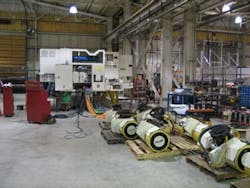One-of-a-Kind Systems Are Custom-Engineered by U.S. Machine Builder
Almost one-third of Doerfer's more-than-500 employees are engineers. That's a lot of technical skill for a company whose initial offerings in 1961 were primarily agricultural equipment design.
While the headquarters have moved from Cedar Falls, Iowa, to Waverly, Iowa, and the machine offerings have expanded to an extensive variety of custom equipment, thanks largely to four U.S. manufacturing locations, the Doerfer name has remained.
Now, its facilities consist of more than 850,000 ft2 of engineering, manufacturing and assembly space, and most of Doerfer's projects are custom-engineered, one-of-a-kind systems that are not available as commercial items. Doerfer also maintains strategic alliances with companies in Europe and the Far East and has installed systems worldwide.
"Doerfer is made up of four wholly-owned operating companies," says Craig Schmeiser, program manager for Doerfer's Wheelift (www.wheelift.com), a heavy transporter. "TDS Automation in Waverly, Iowa, specializes in materials handling and custom turn-key factory automation systems. It's the build location for the Wheelift heavy vehicle product line. This operating division also builds custom AGV systems of lighter capacities. Wright Industries in Nashville, Tennessee, manufactures custom turn-key factory automation systems and extensive nuclear components and systems. Advanced Automation in Greenville, South Carolina, designs and builds custom turn-key factory automation systems. And Williams-White, located in Moline, Illinois, makes heavy presses for the automotive, aerospace and plastics industries.
Although its machines are almost exclusively custom-designed and –built, digital networks are preferred over hardwiring in most instances, explains Schmeiser. "Doerfer has fully embraced Ethernet/IP as a communication backbone for most applications," he says. "As time passes and CIP motion becomes available for wide use, we plan on being a leader in our adoption, as well. Due to the nature of our machinery requiring fast update rates and foolproof operation, Doerfer has decided to wait for a more deterministic and robust wireless platform to be available before moving heavily into the wireless arena."
Doerfer is fully compliant to modern applicable safety needs and standards, says Schmeiser. "The use of appropriate safety devices such as safety monitoring relays, light curtains and area laser scanners compliments our goal to engineer and manufacture safe equipment for our customers," he explains. "Since the recent advent of safety-rated PLCs, Doerfer has begun to utilize them in combination with standard hardware to create highly flexible and safe machinery."
Innovation in the way machine controls and automation are designed at Doerfer is being driven by automation flexibility, the capability for a control platform to be used in multiple diverse applications without undergoing major redesign or reprogramming, explains Schmeiser. "Doerfer strives to reduce cost and time to market for our customers by following design templates and the reuse of modularized code," he says. "Both of those allow us to react to customer needs and yet keep the equipment price inside manageable limits."
Distributed logic controls, much like distributed I/O, has changed the marketplace over the past five years, says Schmeiser. "The next natural step is to move the control of hardware out to the devices," he explains. "In order to make this a reality and to take advantage of emerging market forces such as wireless communications, the control of the component will shift away from a central processor to the component device itself. This has taken place at simplistic levels of control and is very prevalent in conveyor and process industries; it's now time for this ability to move into machinery automation."



